PES Surface Modification Using Green Chemistry: New Generation of Antifouling Membranes
Abstract
:1. Introduction
2. Results and Discussion
3. Experimental Section
3.1. Chemicals and Enzyme Activity
3.2. Membrane Characterization
3.3. Preparation of Model Surfaces and Layer Thickness
3.4. Membrane Modification Experiments
4. Conclusions
Acknowledgments
Conflicts of Interest
References
- Rana, D.; Matsuura, T. Surface Modifications for Antifouling Membranes. Chem. Rev. 2010, 110, 2448–2471. [Google Scholar] [CrossRef] [PubMed]
- Banerjee, I.; Pangule, R.C.; Kane, R.S. Antifouling coatings: Recent developments in the design of surfaces that prevent fouling by protein, bacteria, and marin organisms. Adv. Mater. 2011, 23, 690–718. [Google Scholar]
- Ulbricht, U. Advanced Functional Polymer Membranes. Polymer 2006, 47, 2217–2262. [Google Scholar] [CrossRef]
- Mansouri, J.; Harrisson, S.; Chen, V. Strategies for Controlling Biofouling in Membrane Filtration Systems: Challenges and Opportunities. J. Mater. Chem. 2010, 20, 4567–4586. [Google Scholar] [CrossRef]
- Zhu, X.; Elimelech, M. Colloidal Fouling of Reverse Osmosis Membranes: Measurements and Fouling Mechanisms. Environ. Sci. Technol. 1997, 31, 3654–3662. [Google Scholar] [CrossRef]
- Sahachaiyunta, P.; Koo, T.; Sheikholeslami, R. Effect of Several Inorganic Species on Silica Fouling in RO Membranes. Desalination 2002, 144, 373–378. [Google Scholar] [CrossRef]
- Yamagiwa, K.; Kobayashi, H.; Onodera, M.; Ohkawa, A. Antifoam Fouling and its Reduction by Surfactant Precoat Treatment of Polysulfone Ultrafiltration. Biotechnol. Tech. 1994, 8, 267–270. [Google Scholar] [CrossRef]
- Hanemaaijer, J.H.; Robbertsen, T.; van den Boomgaard, Th.; Gunnink, J.W. Fouling of Ultrafiltration Membranes. The Role of Protein Adsorption and Salt Precipitation. J. Membr. Sci. 1989, 40, 199–217. [Google Scholar] [CrossRef]
- Palacio, L.; Ho, C.-C.; Prádanos, P.; Hernández, A.; Zydney, A.L. Fouling with Protein Mixtures in Microfiltration: BSA-Lysozyme and BSA-Pepsin. J. Membr. Sci. 2003, 22, 41–51. [Google Scholar] [CrossRef]
- Flemming, H.-C.; Schaule, G. Biofouling on Membranes—A Microbiological Approach. Desalination 1988, 70, 95–119. [Google Scholar] [CrossRef]
- Ridgway, H.; Ishida, K.; Rodriguez, G.; Safarik, J.; Knoell, T.; Bold, R. Biofouling of Membranes: Membrane Preparation, Characterization, and Analysis of Bacterial Adhesion. Methods Enzymol. 1999, 310, 463–494. [Google Scholar] [PubMed]
- Frappart, M.; Massé, A.; Jaffrin, M.Y.; Pruvost, J.; Jaouen, P. Influence of Hydrodynamics in Tangential and Dynamic Ultrafiltration Systems for Microalgae Separation. Desalination 2011, 265, 279–283. [Google Scholar] [CrossRef]
- Nady, N.; Franssen, M.C.R.; Zuilhof, H.; Mohy Eldin, M.S.; Boom, R.; Schroën, K. Modification methods for poly(arylsulfone) membranes: A mini-review focusing on surface modification. Desalination 2011, 275, 1–9. [Google Scholar] [CrossRef]
- Bereschenko, L.A.; Prummel, H.; Euverink, G.J.W.; Stams, A.J.M. Effect of Conventional Chemical Treatment on the Microbial Population in a Biofouling Layer of Reverse Osmosis Systems. Water Res. 2011, 45, 405–416. [Google Scholar] [CrossRef] [PubMed]
- Haynes, C.A.; Norde, W. Globular Protein at Solid/Liquid Interface. Colloids Surf. 1994, B2, 517–566. [Google Scholar] [CrossRef]
- Lundström, I. Surface Physics and Biological Phenomena. Phys. Scr. 1983, T4, 5–13. [Google Scholar] [CrossRef]
- Nady, N.; Schroën, K.; Franssen, M.C.R.; Fokkink, R.; Mohy Eldin, M.S.; Boom, R.M.; Zuilhof, H. Enzyme-Catalyzed Modification of PES Surfaces: Reduction in Adsorption of BSA, Dextrin and Tannin. J. Colloid Interface Sci. 2012, 378, 191–200. [Google Scholar] [CrossRef] [PubMed]
- Haynes, C.A.; Norde, W. Structures and Stabilities of Adsorbed Proteins. J. Colloid Interface Sci. 1995, 169, 313–328. [Google Scholar] [CrossRef]
- Minko, S. Grafting on Solid Surfaces: “Grafting to” and “Grafting from” Methods. In Polymer Surfaces and Interfaces: Characterization, Modification and Applications; Manfred, S., Ed.; Springer: Heidelberg, German, 2008; pp. 215–234. [Google Scholar]
- Taniguchi, M.; Kilduff, J.E.; Belfort, G. Low Fouling Synthetic Membranes by UV-Assisted Graft Polymerization: Monomer Selection to Mitigate Fouling by Natural Organic Matter. J. Membr. Sci. 2003, 222, 59–70. [Google Scholar] [CrossRef]
- Vrlinic, T.; Vesel, A.; Cvelbar, V.; Krajnc, M.; Mozetic, M. Rapid Surface Functionalization of Poly(ethersulphone) Foils Using a Highly Reactive Oxygen-Plasma Treatment. Surf. Interface Anal. 2007, 39, 476–481. [Google Scholar] [CrossRef]
- Mu, L.J.; Zhao, W.Z. Hydrophilic Modification of Polyethersulfone Porous Membranes via A Thermal-Induced Surface Crosslinking Approach. Appl. Surf. Sci. 2009, 255, 7273–7278. [Google Scholar] [CrossRef]
- Ma, X.; Su, Y.; Sun, Q.; Wang, Y.; Jiang, Z. Preparation of Protein-Adsorption-Resistant Poly(ethersulfone) Ultrafiltration Membranes through Surface Segregation of Amphiphilic Comb Co-polymer. J. Membr. Sci. 2007, 292, 116–124. [Google Scholar] [CrossRef]
- Rahman, N.A.; Maruyama, T.; Matsuyama, H. Performance of Polyethersulfone/Tetronic1307 Hollow Fiber Membrane for Drinking Water Production. J. Appl. Sci. Environ. Sanit. 2008, 3, 1–7. [Google Scholar]
- Idrisa, A.; Zaina, N.M.; Noordin, M.Y. Synthesis, Characterization and Performance of Asymmetric Polyethersulfone (PES) Ultrafiltration Membranes with Polyethylene Glycol of Different Molecular Weights as Additives. Desalination 2007, 207, 324–339. [Google Scholar] [CrossRef]
- Pieracci, J.; Crivello, J.V.; Belfort, G. Increasing Membrane Permeability of UV-Modified Poly(ethersulfone) Ultrafiltration Membranes. J. Membr. Sci. 2002, 202, 1–16. [Google Scholar] [CrossRef]
- Nady, N.; Schroën, K.; Franssen, M.C.R.; van Lagen, B.; Murali, S.; Boom, R.M.; Mohy Eldin, M.S.; Zuilhof, H. Mild and highly flexible enzyme-catalyzed modification of poly(ethersulfone) membranes. ACS Appl. Mater. Interfaces 2011, 3, 801–810. [Google Scholar] [CrossRef] [PubMed]
- Nady, N.; Schroën, K.; Franssen, M.C.R.; Mohy Eldin, M.S.; Boom, R.M.; Zuilhof, H. Laccase-catalyzed modification of PES membranes with 4-hydroxybenzoic acid and gallic acid. J. Membr. Sci. 2012, 394–395, 69–79. [Google Scholar] [CrossRef]
- Woranuch, S.; Yoksan, R. Preparation, Characterization and Antioxidant Property of Water-Soluble Ferulic Acid Grafted Chitosan. Carbohyd. Polym. 2013, 96, 495–502. [Google Scholar] [CrossRef] [PubMed]
- Mathew, S.; Abraham, T.E. Characterisation of Ferulic Acid Incorporated Starch-Chitosan Blend Films. Food Hydrocolloids 2008, 22, 826–835. [Google Scholar] [CrossRef]
- Schroeder, M.; Aichernig, N.; Guebitz, G.M.; Kokol, V. Enzymatic Coating of Lignocellulosic Surfaces with Polyphenols. Biotechnol. J. 2007, 2, 334–341. [Google Scholar] [CrossRef] [PubMed]
- Kim, S.; López, C.; Güebitz, G.; Cavaco-Paulo, A. Biological Coloration of Flax Fabrics with Flavonoids Using Laccase from Trametes hirsute. Eng. Life Sci. 2008, 8, 324–330. [Google Scholar] [CrossRef] [Green Version]
- Van der Veen, S.; Nady, N.; Franssen, M.C.R.; Zuilhof, H.; Boom, R.M.; Abee, T.; Schroen, K. Listeria monocytogenes Repellence by Enzymatically Modified PES Surfaces. J. Appl. Polym. Sci. 2015, 132. [Google Scholar] [CrossRef]
- Noubigh, A.; Abderrabba, M.; Provost, E. Temperature and Salt Addition Effects on the Solubility Behaviour of some Phenolic Compounds in Water. J. Chem. Thermodyn. 2007, 39, 297–303. [Google Scholar] [CrossRef]
- Singh, G.; Capalash, N.; Goel, R.; Sharma, P. A pH-Stable Laccase from Alkali-tolerant γ-proteobacterium JB: Purification, Characterization and Indigo Carmine Degradation. Enzyme Microb. Technol. 2007, 41, 794–799. [Google Scholar] [CrossRef]
- Xu, F. Effects of Redox Potential and Hydroxide Inhibition on the pH Activity Profile of Fungal Laccases. J. Biol. Chem. 1997, 272, 924–928. [Google Scholar] [CrossRef] [PubMed]
- Dijt, J.C.; Cohen Stuart, M.A.; Hofman, J.E.; Fleer, G.J. Kinetics of Polymer Adsorption in Stagnation Point Flow. Colloids Surf. A. 1990, 51, 141–158. [Google Scholar] [CrossRef]
- Dijt, J.C.; Cohen Stuart, M.A.; Fleer, G.J. Reflectometry as a Tool for Adsorption Studies. Adv. Colloid Interface Sci. 1994, 50, 79–101. [Google Scholar] [CrossRef]
- Nady, N.; El-Shazly, A.H. Laccase-catalyzed Modification of PES Membranes Using Amine-Bearing Modifiers. Desalin. Water Treatm. 2015, 55, 2996–3002. [Google Scholar]

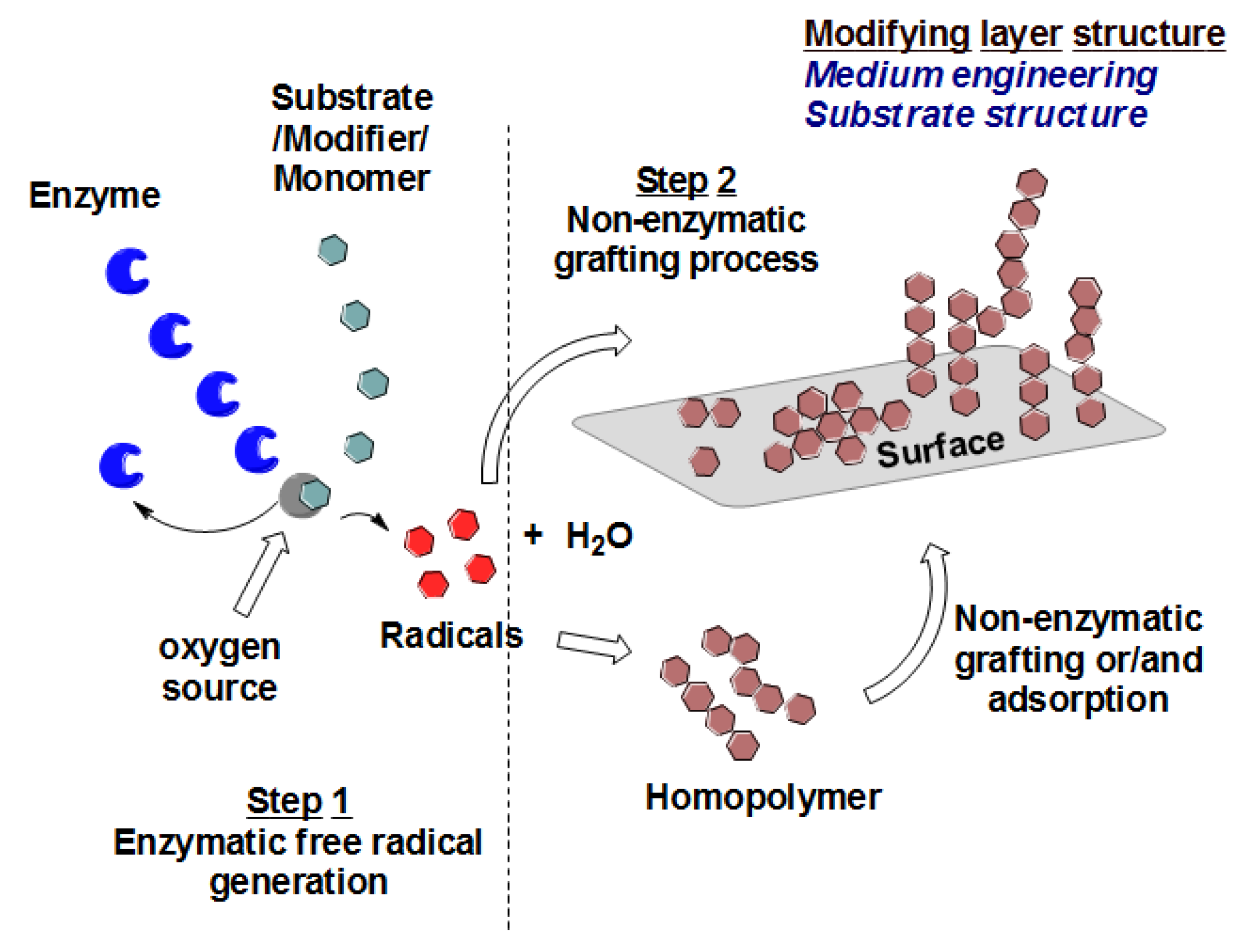
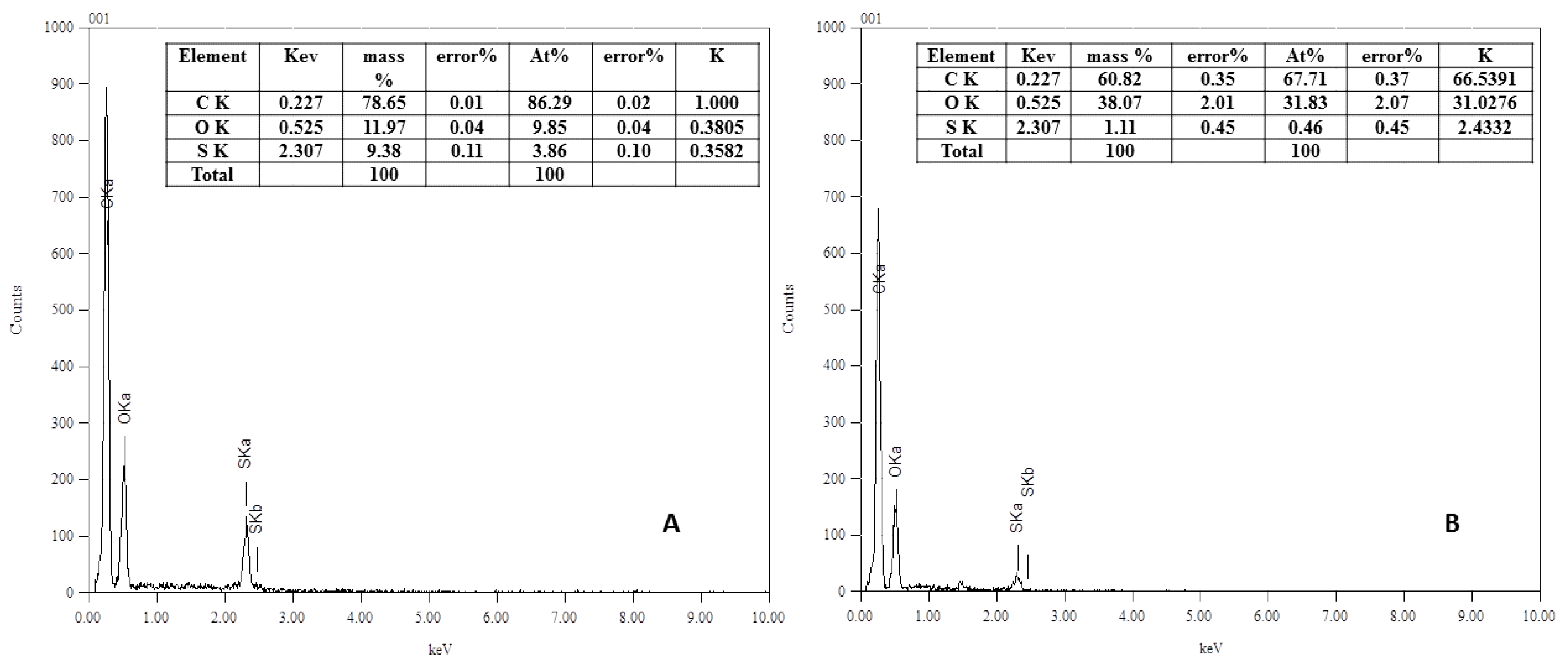
 0.6 mM ferulic acid, and
0.6 mM ferulic acid, and  4.8 mM ferulic acid,
4.8 mM ferulic acid,  ferulic acid concentration (0.6, 1.2, and 4.8 mM) at 8 h modification time, reaction temperature (25, 35, 45, 55, 65 and 75 °C) at 0.5 h modification time,
ferulic acid concentration (0.6, 1.2, and 4.8 mM) at 8 h modification time, reaction temperature (25, 35, 45, 55, 65 and 75 °C) at 0.5 h modification time,  reaction pH (4, 5, 6, and 7),
reaction pH (4, 5, 6, and 7),  enzyme concentration (0.25, 0.5, 0.75, and 1 U·mL−1),
enzyme concentration (0.25, 0.5, 0.75, and 1 U·mL−1),  buffer type (sodium citrate, citrate phosphate, sodium acetate, and phosphate),
buffer type (sodium citrate, citrate phosphate, sodium acetate, and phosphate),  buffer strength (0.05, 0.1, and 0.5 M). Typical errors: ± 0.2 for membrane color change (∆E*) and ± 0.3 µg∙cm−2 for BSA adsorption.
buffer strength (0.05, 0.1, and 0.5 M). Typical errors: ± 0.2 for membrane color change (∆E*) and ± 0.3 µg∙cm−2 for BSA adsorption.
 0.6 mM ferulic acid, and
0.6 mM ferulic acid, and  4.8 mM ferulic acid,
4.8 mM ferulic acid,  ferulic acid concentration (0.6, 1.2, and 4.8 mM) at 8 h modification time, reaction temperature (25, 35, 45, 55, 65 and 75 °C) at 0.5 h modification time,
ferulic acid concentration (0.6, 1.2, and 4.8 mM) at 8 h modification time, reaction temperature (25, 35, 45, 55, 65 and 75 °C) at 0.5 h modification time,  reaction pH (4, 5, 6, and 7),
reaction pH (4, 5, 6, and 7),  enzyme concentration (0.25, 0.5, 0.75, and 1 U·mL−1),
enzyme concentration (0.25, 0.5, 0.75, and 1 U·mL−1),  buffer type (sodium citrate, citrate phosphate, sodium acetate, and phosphate),
buffer type (sodium citrate, citrate phosphate, sodium acetate, and phosphate),  buffer strength (0.05, 0.1, and 0.5 M). Typical errors: ± 0.2 for membrane color change (∆E*) and ± 0.3 µg∙cm−2 for BSA adsorption.
buffer strength (0.05, 0.1, and 0.5 M). Typical errors: ± 0.2 for membrane color change (∆E*) and ± 0.3 µg∙cm−2 for BSA adsorption.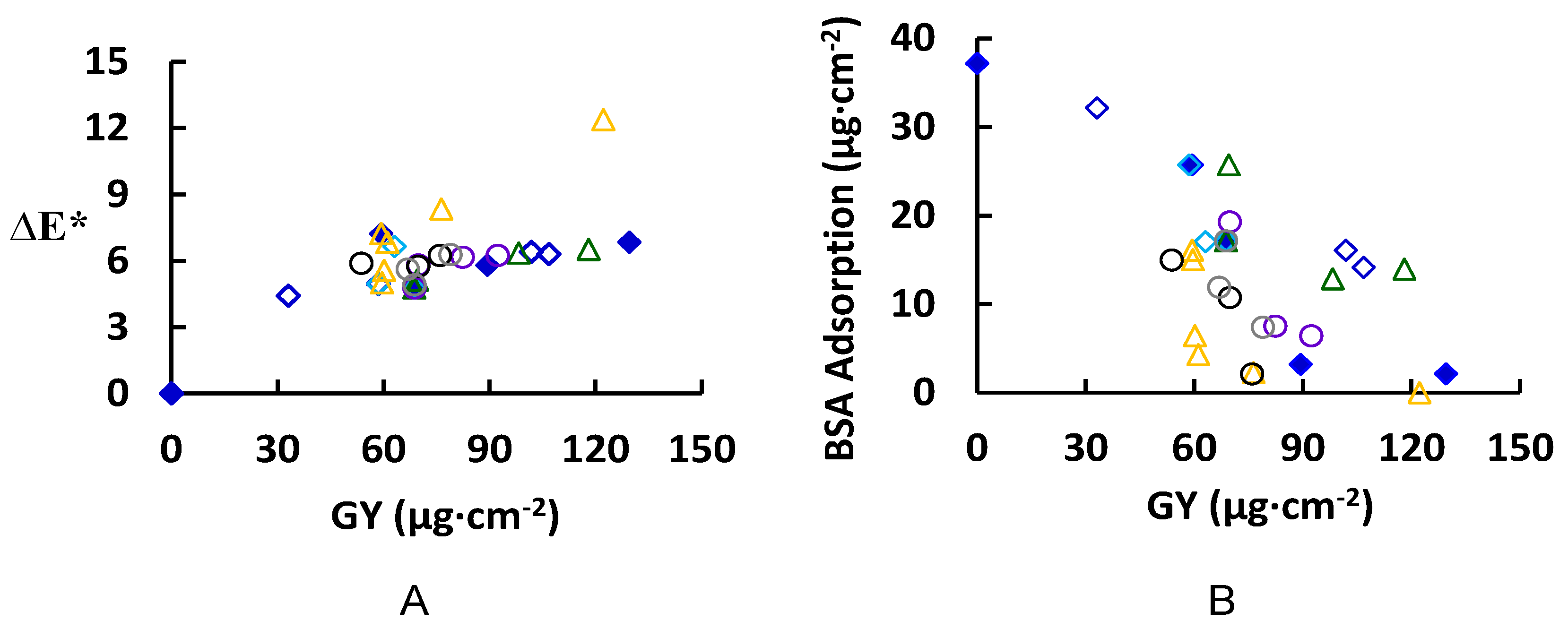

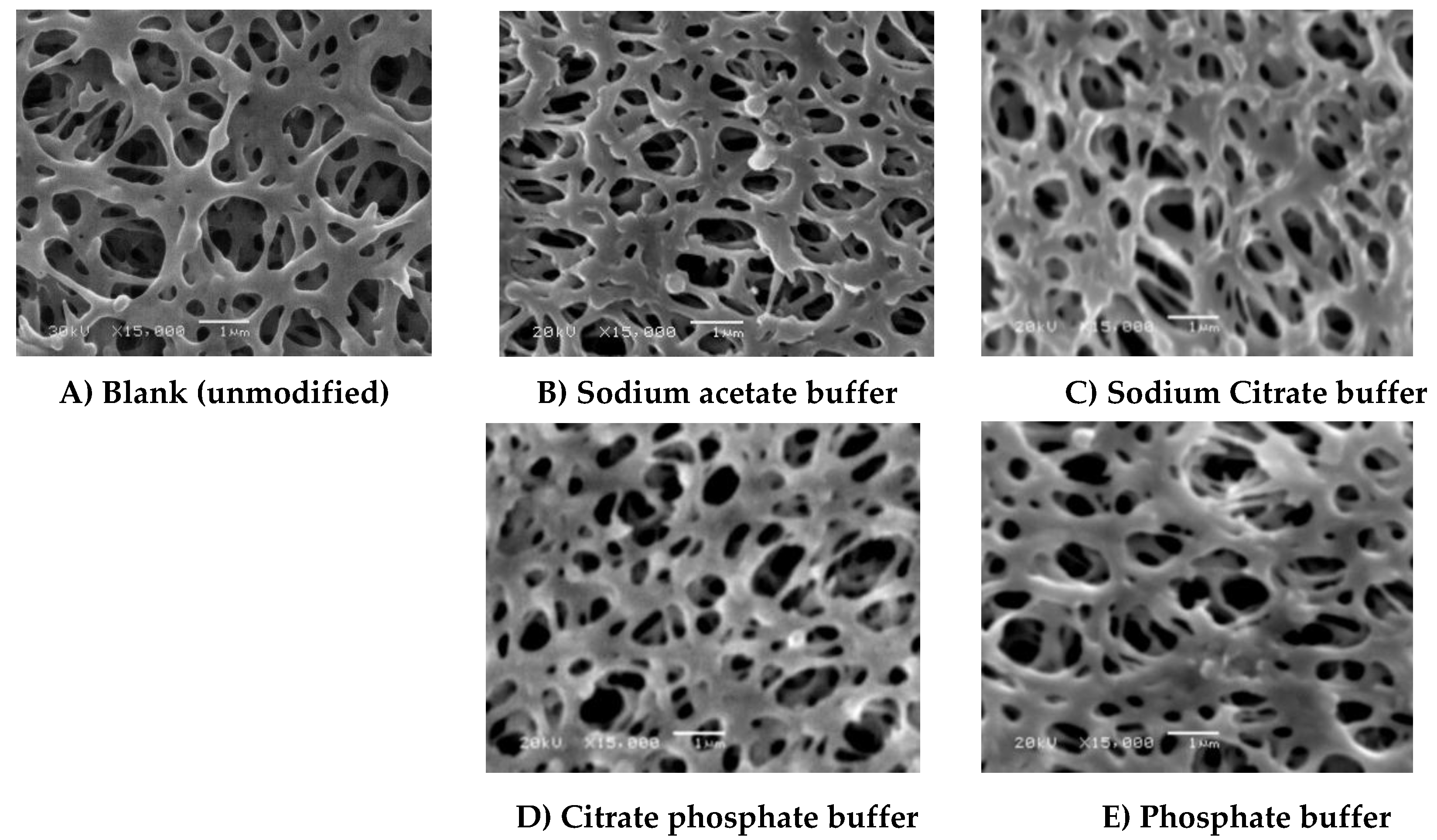
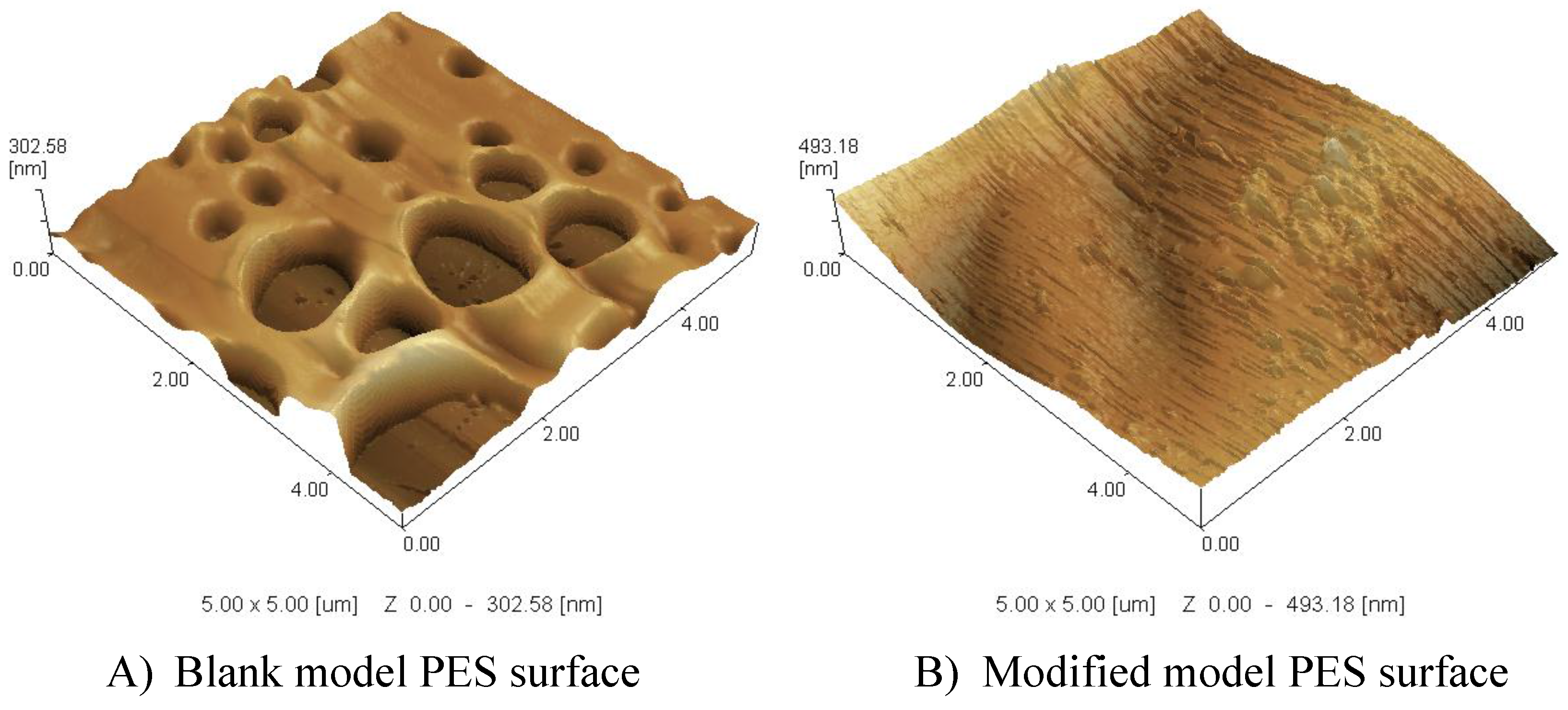
| Bindign Energy (eV) | C1s | C1s | O1s | N1s | S2p |
| 285.4 ± 0.3 | 288.8 ± 0.5 | 533.2 ± 0.3 | 400.1 ± 0.1 | 169.0 ± 0.3 | |
| C–C | C=O | –C–O– | –N– | O=S=O | |
| Sample | Atomic % | ||||
| Blank PES | 77.01 | 16.99 | 15.56 | 2.15 | 5.300 |
| Modified PES by Ferulic acid | 74.77 | 9.985 | 22.38 | 1.01 | 1.845 |
| Modification Condition | Flux Reduction % due to Modification a | Flux Reduction% due to BSA Irreversible Adsorption b | Total Flux Reduction% c | Grafting Yield d (µg∙cm−1) | Total Protein Adsorption e (µg∙cm−1) | Contact Angle f (°) | Layer Thickness g (nm) |
|---|---|---|---|---|---|---|---|
| Real Commercial Membrane | Model PES Surface | ||||||
| Blank (Figure 5A and Figure 6A) | 0 | 24.5 | 24.5 | 0 | 37.2 | 78.8 | 0 |
| Common reaction (Figure 5B) | 8.1 | 1.4 | 9.4 | 68.7 | 17.1 | 63.4 | 8.7 |
| 8 h Modification time (Figure 5C) | 10.1 | 3.9 | 13.7 | 89.4 | 3.2 | 57.8 | 9.8 |
| 1 U∙mL−1 enzymeˑ (Figure 5F) | 12.8 | – | 12.8 | 92.3 | 6.4 | 54.2 | 4.2 |
| pH 7 (Figure 5I) | 8.1 | 5.2 | 12.8 | 118 | 13.9 | 44.2 | 3.9 |
| 65 °C reaction temp.(Figure 5K) | 8.1 | – | 8.1 | 76.4 | 2.2 | 64.4 | 13.4 |
| Sodium citrate buffer (Figure 6C) | – | 5.6 | 5.6 | 75.9 | 2.1 | 61.3 | 7.3 |
| Parameter | 4-hydroxybenzoic Acid | Gallic Acid | Ferulic Acid |
|---|---|---|---|
| Membrane color change | Membrane color change is a good indication for degree or extent of modification | Membrane color change is a good indication for degree or extent of modification | Membrane color change is NOT directly related to degree or extent of modification and color depth should be included (thick layers). |
| GY—average range | 5–30 µg∙cm−2 | 5–30 µg∙cm−2 | 60–100 µg∙cm−2 |
| Add material (%) | 1–2.5 | 1–2.8 | 1–3.5 |
| Flux reduction due to modification (%) | 10–15 | Max. 9 | 8–15 |
| Layer thickness range (nm) (model surface) | 3–15 | 2–10 | 3–16 |
| Contact angle (°) (model surface) | 63–51 | 70–62 | 67–44 |
| Layer growing direction | Two dimensions (2D) brush-like structure | Three dimensions (3D) pancake-like structure | Three dimensions (3D) pancake-like structure |
© 2016 by the author; licensee MDPI, Basel, Switzerland. This article is an open access article distributed under the terms and conditions of the Creative Commons Attribution (CC-BY) license (http://creativecommons.org/licenses/by/4.0/).
Share and Cite
Nady, N. PES Surface Modification Using Green Chemistry: New Generation of Antifouling Membranes. Membranes 2016, 6, 23. https://doi.org/10.3390/membranes6020023
Nady N. PES Surface Modification Using Green Chemistry: New Generation of Antifouling Membranes. Membranes. 2016; 6(2):23. https://doi.org/10.3390/membranes6020023
Chicago/Turabian StyleNady, Norhan. 2016. "PES Surface Modification Using Green Chemistry: New Generation of Antifouling Membranes" Membranes 6, no. 2: 23. https://doi.org/10.3390/membranes6020023






